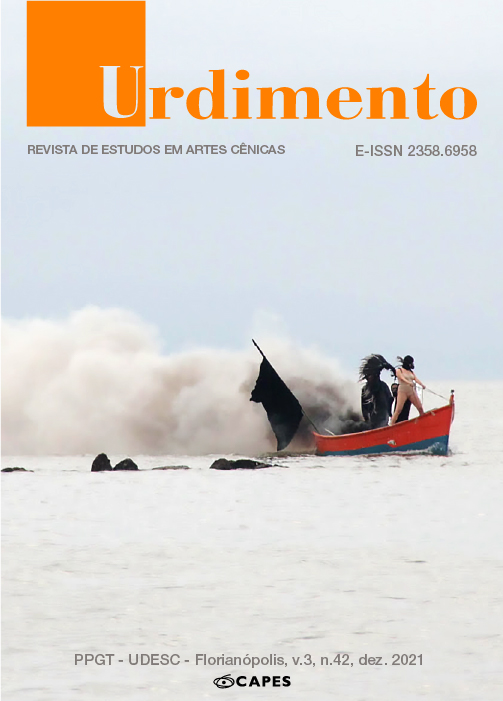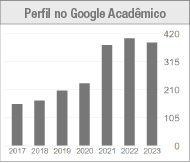Theatrical heterotopias and the conception of energy - Suzuki and the contemporary Japanese scene
DOI:
https://doi.org/10.5965/1414573103422021e0102Keywords:
Japanese theater, Tadashi Suzuki, Heterotopias, Energy, Contemporary sceneAbstract
Once the SITI company was created (1992) by Anne Bogart and Tadashi Suzuki, it became usual to talk about the Suzuki-Viewpoints method. However, some younger artists are unaware of the production of those researches, prior to the partnership. The purpose of this article is to present some characteristics of the early days of what was considered the Suzuki method in 1965, when he created the Waseda Shogekijo (Small Waseda Theatre), until the arrival of his company in Toga. The proposal is not to reconstruct his biography, but to investigate what follows in movement in Suzuki's thought/action, such as the invention of theatrical heterotopias that affect, in different ways, the contemporary Japanese scene, and his singular notion of energy as technology of communication.
Downloads
References
ALLAIN, Paul. The art of stillness. New York: Palgrave Macmillan, 2003.
ARATA, Isozaki. Japan-ness in Architecture. New York: MIT Press, 2006.
CASTRO, Eduardo Viveiros de. Os pronomes cosmológicos e o perspectivismo ameríndio. Mana, Rio de Janeiro, v. 2, n. 2, p. 115-144, 1996. Disponível em: https://www.scielo.br/j/mana/a/F5BtW5NF3KVT4NRnfM93pSs/?lang=pt.
Acesso em: 03 jul. 2021.
CÉLINE, Louis-Ferdinand. L’ école des cadavres. Paris: Les Éditions Denoël,1938.
DERRIDA, Jacques. O animal que logo sou (A seguir). São Paulo: Ed. UNESP, 2002.
FOSTER, Hal. O Retorno do Real. São Paulo: CosacNaify, 2014.
FOUCAULT, Michel. O corpo utópico, as heterotopias. São Paulo: n-1 edições, 2013.
IWAKI, Kyoko. Tokyo Theatre Today – conversations with eight emerging theatre artists. London: Hublet Publishing, 2011.
LEPECKI, André. Exaurir a dança: performance e a política do movimento. São Paulo: Ed. Annablume, 2017.
NUNES, Sandra Meyer. O corpo em equilíbrio, desequilíbrio e fora do equilíbrio. Urdimento, Revista de Estudos em Artes Cênicas, Florianópolis, n. 4, p.90-99, 2002. Disponível em:
https://www.revistas.udesc.br/index.php/urdimento/article/view/1414573101042002090. Acesso em: 03 jul. 2021.
RAQUEL, Fernanda. Corpo artista – estratégias de politização. São Paulo: Ed. Annablume / Fapesp, 2011.
RAQUEL, Fernanda. Emergências do corpo na cena teatral contemporânea – a potência das falhas, desativações e impossibilidades. 2017. Tese (Doutorado em Comunicação e Semiótica) - Pontifícia Universidade Católica de São Paulo, São Paulo, 2017.
YONEYAMA, Shoko. Animism in contemporary Japan – voices for the Anthropocene from post-Fukushima Japan. London: Routledge, 2020.
SHINJIN, Shimizu. Dream Regime – the annihilated body. Translation by Adam Brolinowski, 2002. (No prelo)
SUZUKI, Tadashi. The Way of Acting, the Theater Writings of Tadashi Suzuki, trad. J. Thomas Rimer. New York: Theater Communications Group, 1986.
Downloads
Published
How to Cite
Issue
Section
License
Copyright (c) 2021 Urdimento - Revista de Estudos em Artes Cênicas

This work is licensed under a Creative Commons Attribution 4.0 International License.
Copyright Statement
The articles published by the magazine are free to use. The copyright is all assigned to the magazine. The articles whose authors are identified represent the expression from the point of view of their authors and not the official position of the journal Urdimento. The author (s) undertakes whenever publishing material relating to the article published in Revista Urdimento mention the said publication as follows: This article was originally published by Urdimento magazine in its volume (put the volume), number (put the number) in the year of (put the year) and can be accessed at:
http://www.revistas.udesc.br/index.php/urdimento
This work is licensed under a Creative Commons Attribution 4.0 International License.




